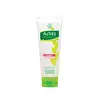What's inside
What's inside
 Key Ingredients
Key Ingredients

 Benefits
Benefits

 Concerns
Concerns

 Ingredients Side-by-side
Ingredients Side-by-side

Water
Skin ConditioningCocamidopropyl Betaine
CleansingGlycerin
HumectantSalicylic Acid
MaskingAcrylates Copolymer
Sodium Lauroyl Methylaminopropionate
CleansingCitric Acid
BufferingAllantoin
Skin ConditioningSodium Benzoate
MaskingPotassium Hydroxide
BufferingSodium PCA
HumectantPotassium Cocoyl Glycinate
Panthenol
Skin ConditioningPotassium Cocoate
EmulsifyingMannitol
HumectantMicrocrystalline Cellulose
AbsorbentSucrose
HumectantZea Mays Starch
AbsorbentHydroxypropyl Methylcellulose
Emulsion StabilisingMica
Cosmetic ColorantTitanium Dioxide
Cosmetic ColorantEctoin
Skin ConditioningWater, Cocamidopropyl Betaine, Glycerin, Salicylic Acid, Acrylates Copolymer, Sodium Lauroyl Methylaminopropionate, Citric Acid, Allantoin, Sodium Benzoate, Potassium Hydroxide, Sodium PCA, Potassium Cocoyl Glycinate, Panthenol, Potassium Cocoate, Mannitol, Microcrystalline Cellulose, Sucrose, Zea Mays Starch, Hydroxypropyl Methylcellulose, Mica, Titanium Dioxide, Ectoin
Water
Skin ConditioningGlycerin
HumectantPalmitic Acid
EmollientGlyceryl Stearate
EmollientMyristic Acid
CleansingPotassium Hydroxide
BufferingLauric Acid
CleansingButylene Glycol
HumectantOlea Europaea Fruit Oil
MaskingLauramide DEA
Potassium Cocoyl Glycinate
Lauryl Hydroxysultaine
CleansingPotassium Chloride
Alcohol Denat.
AntimicrobialParfum
MaskingCI 77891
Cosmetic ColorantTocopheryl Acetate
AntioxidantO-Cymen-5-Ol
AntimicrobialDipotassium Glycyrrhizate
HumectantArctostaphylos Uva-Ursi Leaf Extract
Skin ConditioningMagnesium Ascorbyl Phosphate
AntioxidantLactic Acid
BufferingArbutin
AntioxidantSodium Acetylated Hyaluronate
HumectantWater, Glycerin, Palmitic Acid, Glyceryl Stearate, Myristic Acid, Potassium Hydroxide, Lauric Acid, Butylene Glycol, Olea Europaea Fruit Oil, Lauramide DEA, Potassium Cocoyl Glycinate, Lauryl Hydroxysultaine, Potassium Chloride, Alcohol Denat., Parfum, CI 77891, Tocopheryl Acetate, O-Cymen-5-Ol, Dipotassium Glycyrrhizate, Arctostaphylos Uva-Ursi Leaf Extract, Magnesium Ascorbyl Phosphate, Lactic Acid, Arbutin, Sodium Acetylated Hyaluronate
Ingredients Explained
These ingredients are found in both products.
Ingredients higher up in an ingredient list are typically present in a larger amount.
Glycerin is already naturally found in your skin. It helps moisturize and protect your skin.
A study from 2016 found glycerin to be more effective as a humectant than AHAs and hyaluronic acid.
As a humectant, it helps the skin stay hydrated by pulling moisture to your skin. The low molecular weight of glycerin allows it to pull moisture into the deeper layers of your skin.
Hydrated skin improves your skin barrier; Your skin barrier helps protect against irritants and bacteria.
Glycerin has also been found to have antimicrobial and antiviral properties. Due to these properties, glycerin is often used in wound and burn treatments.
In cosmetics, glycerin is usually derived from plants such as soybean or palm. However, it can also be sourced from animals, such as tallow or animal fat.
This ingredient is organic, colorless, odorless, and non-toxic.
Glycerin is the name for this ingredient in American English. British English uses Glycerol/Glycerine.
Learn more about GlycerinPotassium Cocoyl Glycinate is an amino acid-based surfactant and cleaning agent. This ingredient can be derived from animals or plants. It may also be synthetically created from fatty acids of the coconut and glycine.
Potassium Cocoyl Glycinate is a gentle surfactant. Surfactants help gather the dirt, oil, and other pollutants from your skin to be rinsed away. It is a mild cleanser and naturally produces foam.
Potassium hydroxide is commonly known as caustic potash. It is used to fix the pH of a product or as a cleaning agent in soap. In cleansers, it is used for the saponification of oils.
Sapnification is the process of creating fatty acid metal salts from triglycerides and a strong base. During this process, Potassium Hydroxide is used up and is not present in the final product.
Using high concentrations of Potassium Hydroxide have shown to irritate the skin.
Learn more about Potassium HydroxideWater. It's the most common cosmetic ingredient of all. You'll usually see it at the top of ingredient lists, meaning that it makes up the largest part of the product.
So why is it so popular? Water most often acts as a solvent - this means that it helps dissolve other ingredients into the formulation.
You'll also recognize water as that liquid we all need to stay alive. If you see this, drink a glass of water. Stay hydrated!
Learn more about Water